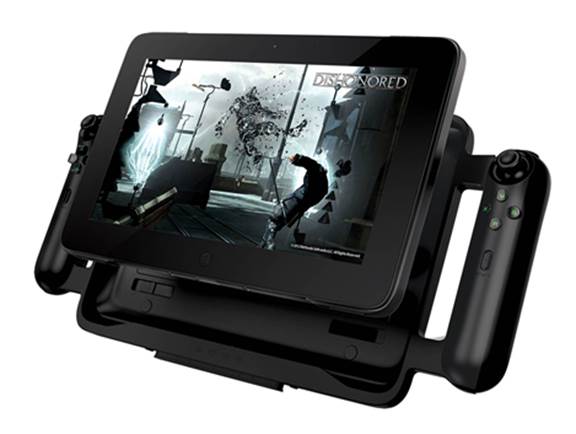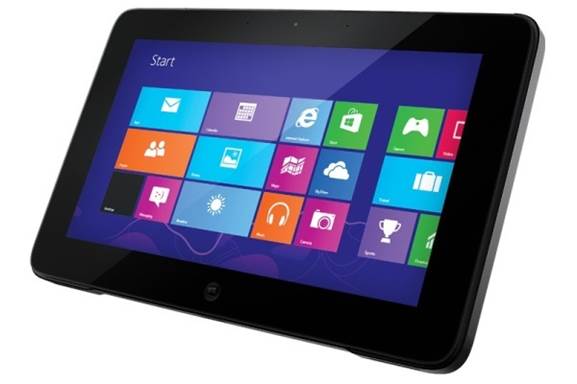It sounded so good on paper...
The razer edge sounds fantastic: a Windows
8 tablet, notebook, and portable gaming system in one. But in actual use, the
Edge is a letdown.
The Edge starts at $1,000, with the Pro
climbing up to $1,450. That may be pricey for a
"tablet," but it comes with a Core i7-3517U, Nvidia GT 640M LE, 8GB
of DDR3/1600, and a 256GB SSD. While it's supposed to be the happy love-child
of a portable tablet and a powerful PC, the end result is a compromised
monstrosity.

Razer
Edge Pro
The first thing you'll notice about the
Edge is its bulk. Measuring 10.9x7x.8 inches and weighing two pounds, 2.1
ounces, it's big, thick, and heavy for a tablet, basically requiring you to
rest it on your body for support. This in turn muffles the otherwise excellent
speakers, which are placed on the bottom edge. And flipping the Edge upside
down isn't a great solution, as you might accidentally trigger the power button
on the opposite edge.
Other external controls and ports include a
volume rocker, auto-rotate lock, a virtual keyboard button, a USB 3.0 port, and
a headphone jack. The intake and exhaust vents are quite large and often noisy;
you’ll hear the fans revving even when just web browsing.
The Edge's IPS screen offers fantastic
viewing angles. While the glossy five-point touch display features just a
1366x768 resolution, its 10.1-inch screen still offers a decent
155.1-pixel-per-inch (PPI) density. Our MSI GT60’s 15.6-inch screen has a 141.2
PPI, for example. We aren’t fans of the thick one-inch bezel, though, as it
made us wish we had Stretch Armstrong's thumbs.

Other
external controls and ports include a volume rocker, auto-rotate lock, a
virtual keyboard button, a USB 3.0 port, and a headphone jack
Our biggest issue with the Edge, however,
is that it lacks a physical keyboard. While Windows 8 might be better with
touch, it sucks with only touch. Navigating through desktop mode was a headache
because a lot of the tiny icons were clearly designed for the precision of a
mouse/trackpad. Even if you were to hook up a Bluetooth keyboard/mouse, you
still can't effectively use the Edge as a proper desktop PC because it doesn't
have a stand. (An optional dock with additional ports could serve as a stand,
at the added cost of $100.)
The Edge also had connectivity issues with
our Linksys E1200 router, often disconnecting or running terribly slowly, and
Razer acknowledged problems with Linksys routers in general. Belkin and D-Link
routers fared better, but the download speeds were often a quarter of our
zero-point's sitting a foot away.
The Edge didn't fare any better in our
standard performance benchmarks. The closest it got to our zero-point in CPU intensive
tests was in ProShow, where the Edge’s 1.9GHz-clocked CPU lagged just 22
percent. In our multithread-hungry x264 benchmark, it got crushed by 54
percent. In our GPU tests, it fell 14 percent behind in STALKER, and got
severely beaten down in 3DMark 11. The Edge couldn't even keep up in the
battery department!
At the end of the day, you shouldn't expect
a tablet to perform on par with a beefy gaming notebook. (We’re including the
benchmarks for reference only.) The Edge was designed to run games on medium
settings, and for the most part, it succeeds. We played Borderlands 2, an
Unreal Engine game, and got a consistent 40fps. The Edge was actually able to
max out Portal 2, a Source Engine game, with frame rates in the high 80s. On
the more graphically demanding Far Cry 3, however, we saw a 31fps average,
which tells us settings should be lowered.
If you’re looking to play these games with
the Edge’s optional controller peripheral, you shouldn’t, as the Edge ends up
weighing four pounds, which is much too heavy. It’s also overpriced at $250.
The much-needed keyboard add-on also isn’t available yet, nor is its price
known. The dock mentioned above, meanwhile, is a necessity. For its $100 you'll
get three USB ports, an HDMI-out, and a much-needed stand, but it lacks an Ethernet
port.

While
the Edge is much more usable if you purchase the right accessories, that drives
up the price and limits its portability
While the Edge is much more usable if you
purchase the right accessories, that drives up the price and limits its portability.
You're better off purchasing a laptop to satiate your gaming needs and a Nexus
7 to get your portability fix which you can do for about the same price of the
Edge with all the peripherals it needs to be useful.
We really wanted to like the Edge, but the
design limitations currently make this a better idea on paper. At present, this
is one dull Edge.
|
Specifications
·
CPU: 1.9GHz Intel Core i7-3517U
·
RAM: 8GB DDR3/1600
·
Chipset: Intel HM76
·
GPU:
Nvidia GT 640M LE 2GB GDDR3
·
Display: 10.1-intli, 1366x768 IPS display
(glossy)
·
Storage: 256GB SSD
·
Connectivity: 1x USB 3.0, audio in, 2MP
webcam, Bluetooth, 802.11n
·
Lap/Carry: 2 lbs, 2.1 oz/2lbs, 12.5 oz
|